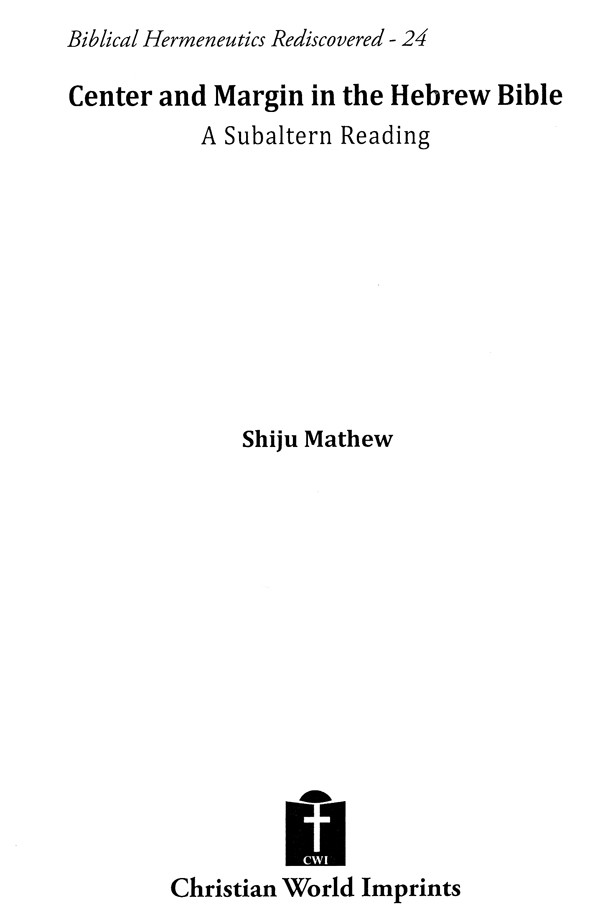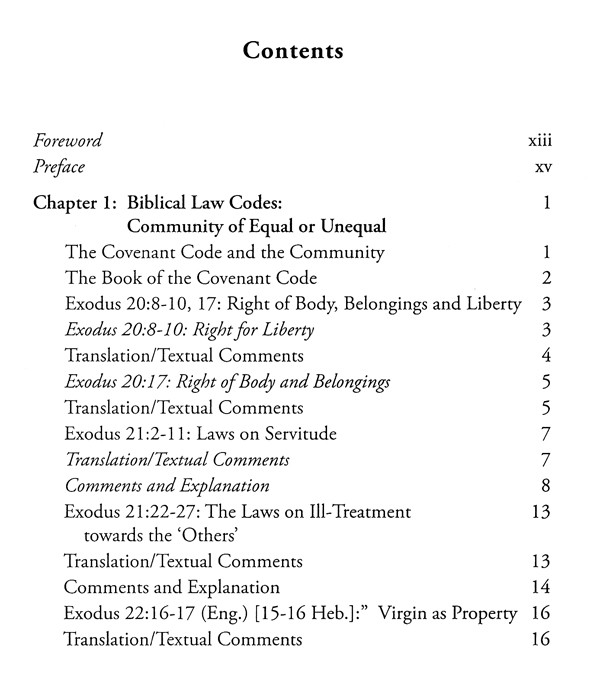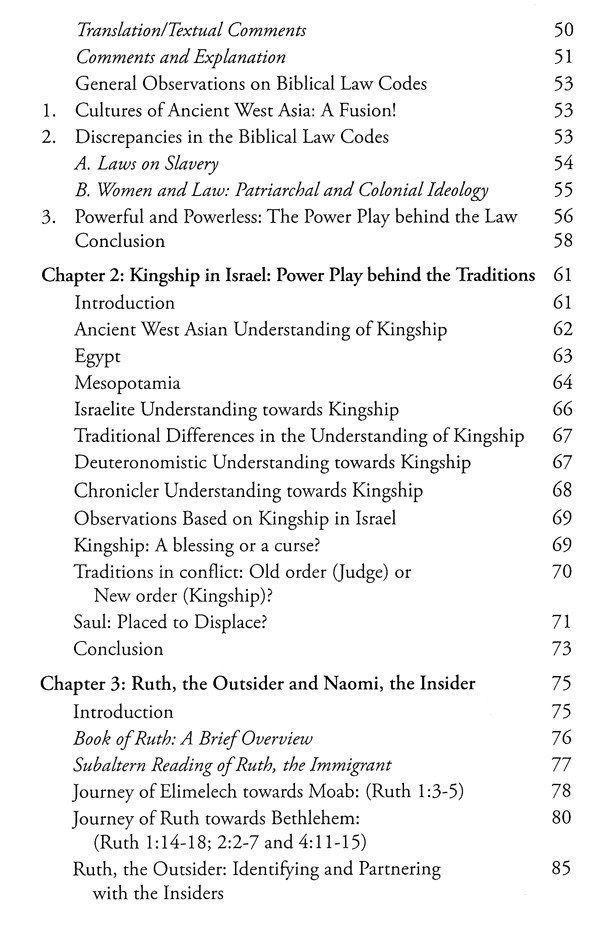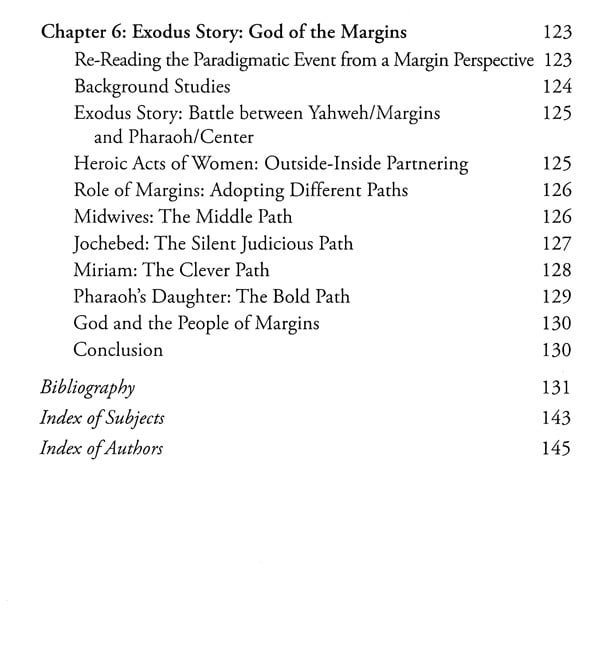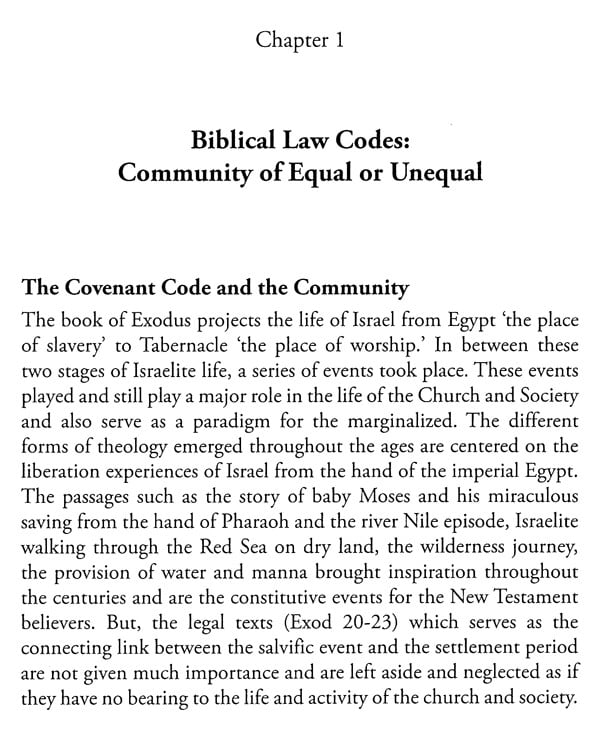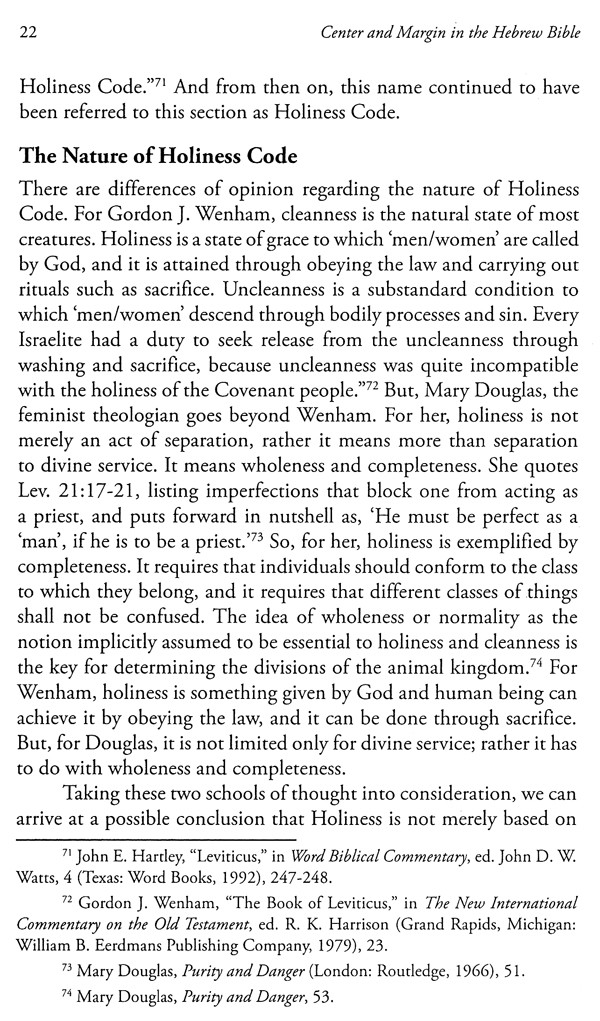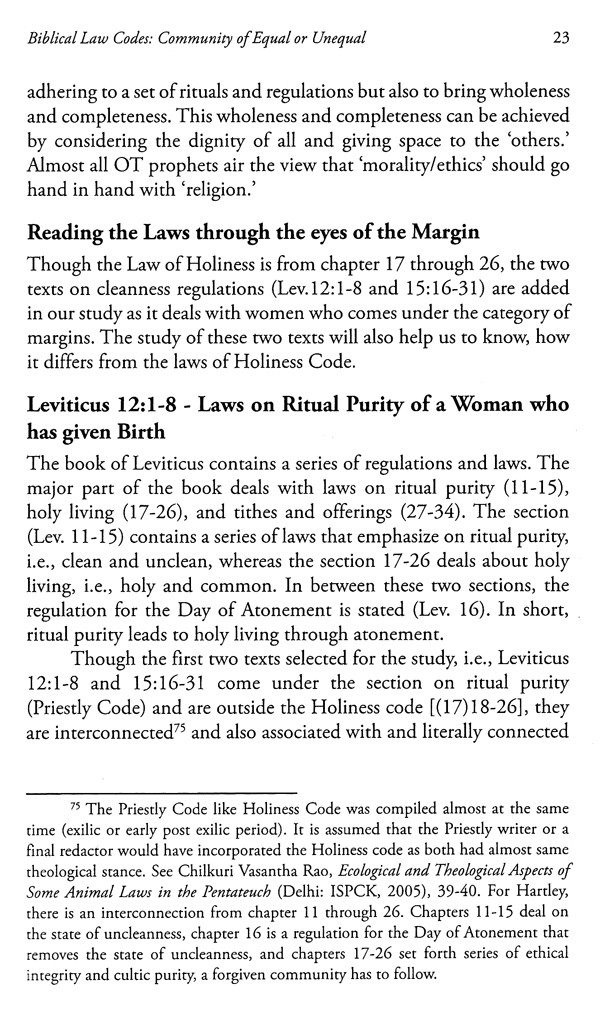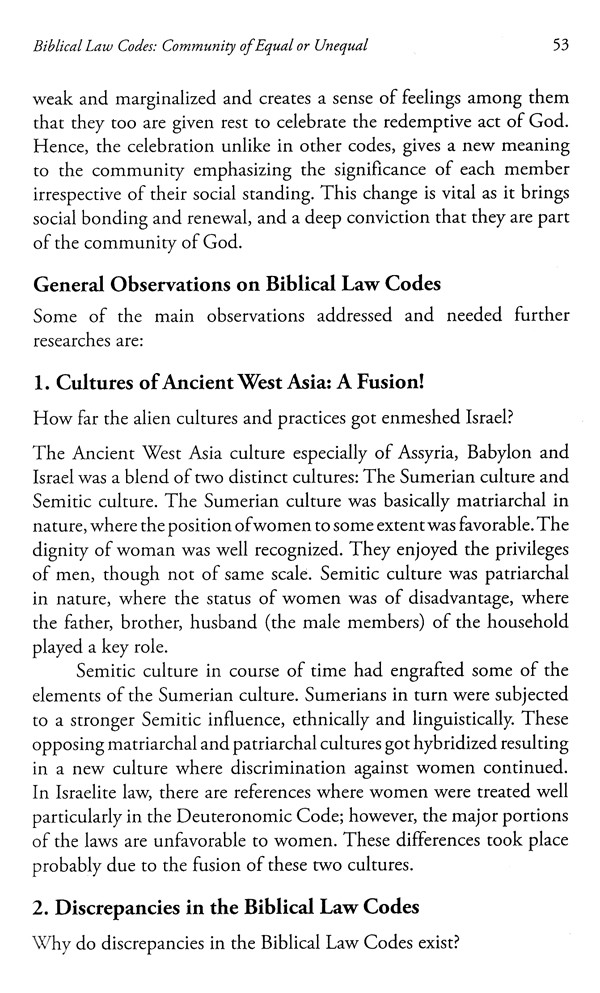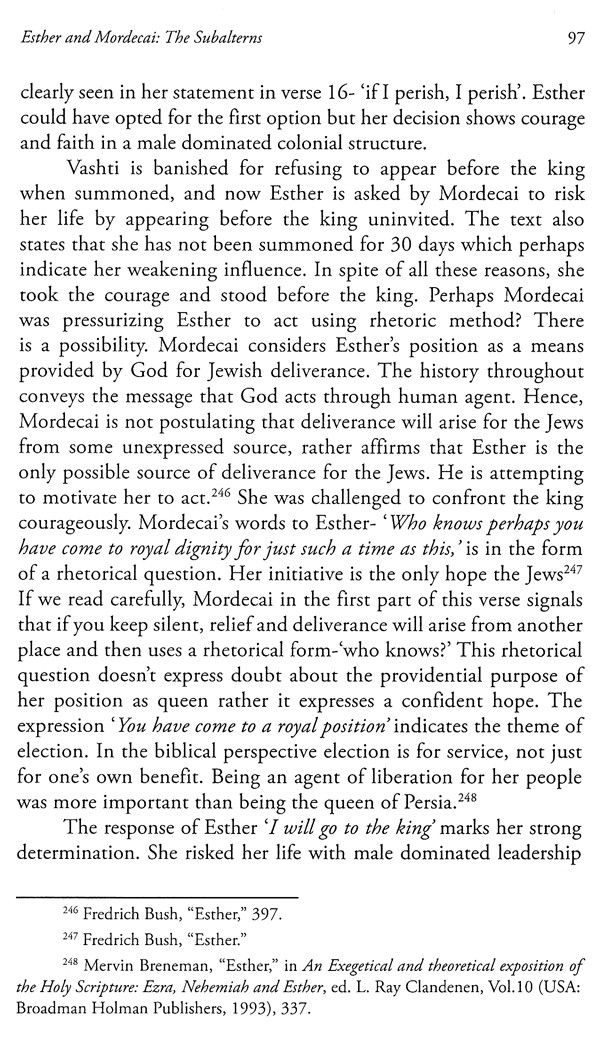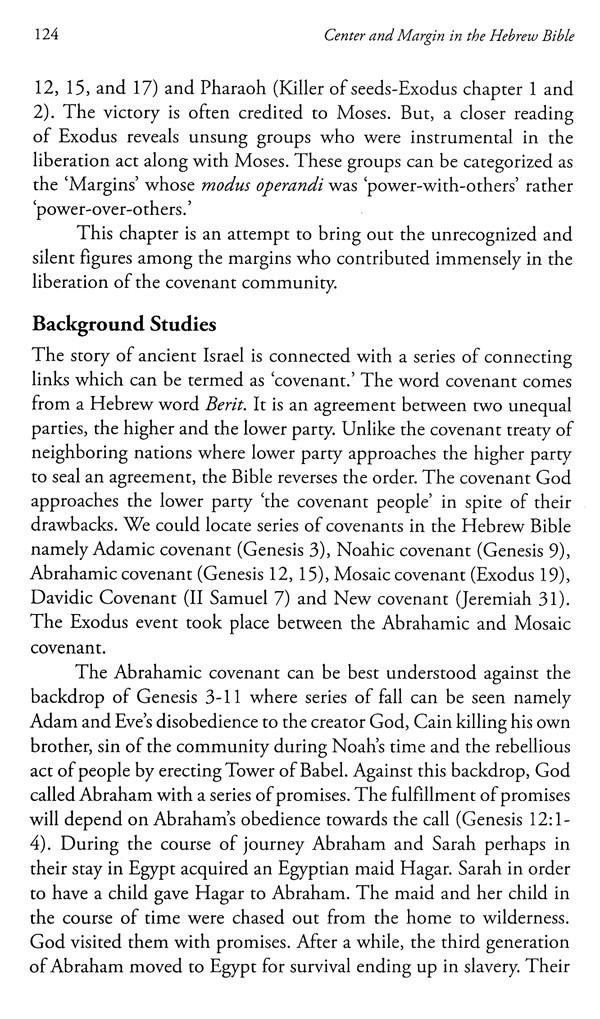
Center and Margin in the Hebrew Bible (A Subaltern Reading)
Book Specification
| Item Code: | UBA564 |
| Author: | Shiju Mathew |
| Publisher: | Christian World Imprints, Delhi |
| Language: | English |
| Edition: | 2019 |
| ISBN: | 9789351483960 |
| Pages: | 161 |
| Cover: | HARDCOVER |
| Other Details | 9.00 X 6.00 inch |
| Weight | 380 gm |
Book Description
The book is about the role of Center and Margins in family, society and the nation. We are living in a world where people in the center dominate the people living in the margin/periphery. In order to address the issue of center and margin taking into account of both patriarchal and colonial ideologies behind, the author has attempted to bring out six chapters to re-read and re- define the people of center and margin.
This scholarly work brings out a macro sociological and subalternal analysis which could propose a new arena of Socio-cultural world of the Hebrew Bible. The book deals with the Biblical Law Codes (Book of the Covenant Code, Holiness Code and the Deuteronomic Code), Kingship in Israel comparing it with Ancient West Asian kingship and Women in the Hebrew Bible.
The author is an ordained minister of CEA. His theological journey started in the year 1992. He did BD from Faith Theological Seminary, Manakala; M.Th (Old Testament) from Union Biblical Seminary, Pune; and D.Th (Old Testament) from United Theological College, Bangalore. All these colleges/seminaries are affiliated to the Senate of Serampore College (University).
The author served with Gospel for Asia (1996-99); with New Theological College, Dehradun on various positions as Associate Professor, Registrar, Academic Dean and Acting Principal (2001-18). At present, he is serving at Union Biblical Seminary, Pune as Associate Professor, Head of the Department (OT) and Dean of Postgraduate Program. He was part of M.Th Curriculum committee (SSC) and member of the board of study of Old Testament (SSC). He is a qualified supervisor for Doctoral research program (SSC). He serves as a subject expert (biblical division) at Adventist Spicer University, Pune. He has authored a book titled, Biblical Law Codes in Creative Tension: A Postcolonial Womanist Reading and has also written and contributed numerous articles in various journals and edited books.
The present volume is a collection of studies focusing on the theme 'Center and Margin.' With the exception of chapters five and six, and parts of chapter one, all other chapters with some changes are published in Indian and International Journals and in edited books. The journals and edited books in which the other chapters were published are: Ruth, a Moabite Gentile Woman Blessing the Nation Israel: A Subaltern Reading, NLTJ, Vol.3, No.2, 2013: 69- 77; Law, Land and Gender in the Hebrew Bible: A Postcolonial Womanist Reading, AJT, Vol.30, no.2, 2016: 177-192; Affirming the Monotheistic Faith Through Action: Reading the Book of Esther in the Shadow of Persian Imperialism, UBS Journal. Vol.12.2, 2018: 35-56; Kingship in Israel: Power Play Behind the Traditions, Vol.8, No.2, 2018: 96-107; Deuteronomy and Women Rights: A Subaltern Reading, in Journeys into the Deep: Hermeneutical Patterns of M. M. Thomas, ed. C. I. David Joy and P. Mohan Larbeer, Bangalore: BTESSC, 2016, 53-73 and Ruth: The Immigrant, a Journey from Moab to Bethlehem, Re-Imagining Reformation: Essays in Honor of P. G. George, ed. Y. T. Vinayaraj, Dexter Maben and Woba James, Delhi: ISPCK, 2017, 223-237.
The studies are revised and modified to connect it with the central theme 'Center and Margin.' The materials for them are gathered mainly from libraries in Bangalore, Dehradun and Pune.
The book deals with the Biblical Law Codes (Book of the Covenant Code, Holiness Code and the Deuteronomic Code), Kingship in Israel comparing it with Ancient West Asian kingship and Women in the Hebrew Bible.
The projection of the book is to initially bring out the characters of both the Center and the Margin. In Biblical Law Codes, the author brought out selected texts to portray the position of women in all three codes namely the Covenant Code, the Holiness Code and the Deuteronomic Code to project whether it is community of equal or unequal. In the second chapter, the author pointed out that the kingship in ancient Israel was an ill-timed one and was borrowed heavily from the neighboring nations. Since it was not a divinely ordained institution instead of blessings, it fragmented the peace and tranquility of the Israelite society. The powerful dominated the powerless and tradition of center dominated the tradition of margin. The chapter on Ruth, the Outsider and Naomi, the Insider points out how a Moabite woman being a widow changed her social identity of margin among the people of center. The partnering of both the outsider (Ruth) and the insider (Naomi) changed the identity crisis to an identity of respect and honor. The chapter on Esther and Mordecai: The Subalterns focuses how the margin exposed the center using reversal strategy. The passive characters shifted as active characters using banquet strategy. Here also we can see the inside (woman of margin) and outside (man of margin) partnering to foil the plan and strategy of center (Haman). The penultimate chapter is center and margin within the women's world focusing on two characters Sarah and Hagar. Sarah the Center dominated Hagar the Margin. The role of Abraham was passive in nature but God appeared to Hagar and assured the promises of divine presence and blessings of generation similar to Abrahamic promise. In the final chapter, the author brought out the role of margins in delivering and upbringing Moses, the liberator. All women characters took different paths: Midwives took the middle path; Jochebed, the silent but judicious path; Miriam, the wise path; and Pharaoh's daughter. the bold path. All these paths are essential as people of margin to defy the power and order of center.
The Revd. Dr Shiju Mathew is an established scholar and theological educator in the field of the Old Testament. As a researcher, teacher and pastor he has been contributing substantially in the field of biblical hermeneutics. Recently, his doctoral dissertation was published and the same was received by the scholarly community with enthusiasm and openness. Now he has prepared a book entitled Center and Margin in the Hebrew Bible: A Subaltern Reading. This book is divided into six chapters dealing with the issues of kingship, power, otherness and gender. In our context, these are some of the burning issues which can define and redefine the question of identity of the people of God.
The strength of this book is, according to my opinion, a macro sociological and subalternal analysis which could propose a new arena of Socio-cultural world of the Hebrew Bible. The texts generally present characterization of subaltern communities by depicting the characters within the framework of subalternity. It is significant to note the unique feature of Dr Shiju's interpretation namely the issue of center and the margins defined with the help of the relevant texts.
In our context of pluralism, any discussion on subalternity is significant as the same will present a new direction in terms of the emancipation of the people of the margins. I am sure, this book will initiate a new debate in the field of subaltern hermeneutics in India.
**Contents and Sample Pages**
